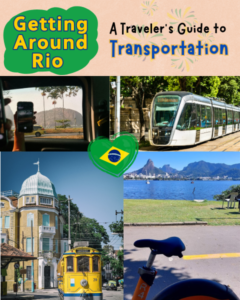
Rio is a vibrant, sprawling city with stunning beaches, buzzing nightlife, and plenty of hidden gems to explore. But before you dive into her magic, you’ll need to figure out how to get around. Whether you’re touching down at the airport, hopping on a local bus, or catching a taxi, this guide will help you navigate Rio’s transportation system with confidence — even if you don’t speak Portuguese.
Getting to and From Rio’s Airports
Rio has two main airports:
- Galeão International Airport (GIG): The main airport for international travelers, located about 20km (12 miles) from Copacabana.
- Santos Dumont Airport (SDU): Primarily serves domestic flights and is conveniently located near downtown Rio.
Transportation Options from the Airport
Taxi
- Common Yellow Taxis: Available outside the airport but might overcharge tourists. If you choose this option, insist on the meter (“no taxímetro”).
- Prepaid Airport Taxis: More expensive but hassle-free; you pay a fixed rate at a counter inside the airport. This is the best option if you want to use taxi
- Executive Taxis: Blue or white vehicles that offer better service and comfort but cost more.
Rideshare Apps
- Uber and 99 are available and generally cheaper than taxis. You’ll need internet access to request a ride, so consider getting a SIM card at the airport [add Affiliate link and copy here for esim]. For Uber, you need to follow the signs to the Uber Lounge which is located outside the arrivals terminal.
Airport Buses (Frescão)
- The Premium Airport Bus (Real Auto Ônibus) runs between GIG and major neighborhoods like Copacabana and Ipanema. Tickets cost around R$20-30, and it’s a safe, comfortable option.
Public Buses: Cheap but Tricky
Rio’s buses cover nearly every corner of the city and are an inexpensive way to get around. However, they can be chaotic and tricky for tourists who don’t speak Portuguese.
How to Ride the Bus
- Payment: Pay in cash (small bills/coins) or use a rechargeable Riocard Mais, available at metro stations.
- Cost: Around R$4.30 per ride.
- Boarding: Enter through the front door and pay the driver or use your Riocard.
- Safety Tips: Keep an eye on your belongings, avoid buses at night in unfamiliar areas, and prefer air-conditioned buses (frescão) for longer trips.
Metro: The Easiest Public Transport for Tourists
- Lines & Hours: Two main lines, operating from 5 am to midnight (or 11 pm on Sundays).
- How to Pay: Use a Riocard Mais or buy a single ticket (~R$6.90).
- Safety: The metro is clean, efficient, and safer than buses. Avoid rush hours (7-9 am and 5-7 pm).
Taxis: Different Types & How to Stay Safe
Taxis in Rio can be hit or miss, so here’s what you need to know:
Types of Taxis
- Regular Yellow Taxis: Found everywhere, but drivers may refuse to use the meter.
- Radio Taxis: More expensive but reputable and can be booked via phone or app.
- Executive Taxis: Available at hotels and airports, offering a premium service.
Tips for Taking a Taxi
- Always ask for the meter (“no taxímetro”).
- Use official taxi stands at airports and bus terminals.
- Consider using a rideshare app instead for predictable pricing.
Rideshare Apps: The Most Convenient Option
Rideshare apps are widely used in Rio, and they offer safer and more affordable alternatives to taxis.
Available Apps
- Uber: The most popular option, with choices like UberX (cheap), Uber Black (luxury) or Uber motorcycle, if you want to skip traffic.
- 99: Similar to Uber, sometimes offering lower fares.
Tips for Using Rideshare Apps
- Always confirm the driver’s details before getting in.
- Avoid requesting rides in sketchy areas late at night.
- Set your pickup location carefully at airports to avoid confusion.
Other Ways to Get Around Rio
Bike Rentals
- Bike Itaú: Rio’s public bike-sharing system, great for short rides along the beach. Use the Tembici app to rent.
Walking
- Safe in busy areas like Copacabana and Ipanema during the day, but avoid deserted streets at night.
Car Rentals
- Not recommended unless you’re planning day trips outside the city. Traffic and parking are a nightmare.
More Tips for Getting Around Rio
- Download Google Maps & Moovit: These apps help with public transport navigation.
- Carry Small Bills & Coins: Especially for buses and taxis.
- Stay Alert: Like any big city, pickpockets are common in crowded transport areas.
- Ask for Help: Cariocas (locals) are friendly and will often help if you ask politely.
With this guide, you’re ready to navigate Rio like a pro! Whether you’re hopping on a bus, catching an Uber, or cycling along the beach, you’ll have no trouble getting from A to B. Enjoy the ride like a Rio local.
Did you find this guide helpful? Follow us for more insider Rio travel tips.



Leave a Reply